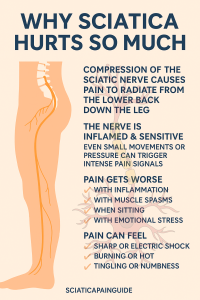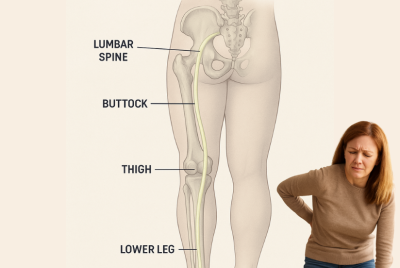Why Is Sciatica So Painful? Understanding What Makes This Nerve Pain So Intense
🌟 When Sciatica Feels Unbearable
If you’ve ever experienced sciatica pain, you know it’s unlike any ordinary backache. It’s a deep, radiating pain that can shoot from your lower back down your leg — sharp, electric, and sometimes unbearable. But why is sciatica so painful compared to other types of pain?
To answer that, we need to look at how the sciatic nerve, the largest nerve in your body, works — and what happens when it’s irritated or compressed.
In this guide, we’ll break down what makes sciatica so painful, explore the main causes of severe sciatic nerve pain, and share practical tips to calm the discomfort naturally.
💡 What Exactly Is Sciatica?
Sciatica is not a condition itself — it’s a symptom of nerve compression or irritation. The sciatic nerve begins in the lower spine (the lumbar region) and travels through your hips, buttocks, and legs, ending at your feet.
When something pinches or inflames this nerve, it sends pain signals along the entire pathway. That’s why sciatic nerve pain can feel like it’s traveling down one side of your body — from your lower back all the way to your toes.
⭐ Common causes include:
-
Herniated or bulging discs pressing on the nerve
-
Spinal stenosis (narrowing of the spinal canal)
-
Piriformis syndrome (a tight hip muscle compressing the nerve)
-
Arthritis or bone spurs
-
Inflammation or injury in the lower back
Each of these issues can create pressure or inflammation that irritates the nerve, leading to the burning, shooting, or throbbing pain that sciatica is known for.
🔍 Why Sciatica Hurts So Much: The Science of Nerve Pain
So, why does sciatica hurt so much compared to other types of pain? It comes down to how nerve pain (neuropathic pain) behaves.
Unlike muscle or joint pain — which stays localized — nerve pain follows the entire pathway of the nerve. The sciatic nerve is extremely large and sensitive, so when it’s inflamed, it sends intense signals all the way down the leg.
⭐ Key reasons sciatica pain gets worse include:
-
The nerve controls multiple areas at once.
The sciatic nerve branches out into smaller nerves in the thigh, calf, and foot — so pain can radiate widely. -
Inflammation amplifies pain signals.
When tissue around the nerve becomes swollen, the pressure increases nerve sensitivity, making even light movement painful. -
Nerve pain is “electric.”
Because the sciatic nerve carries electrical impulses, compression creates sharp, shooting, or burning sensations. -
Muscle spasms worsen the problem.
Muscles around the affected area tighten to “protect” the nerve, which ironically increases pressure and discomfort. -
Your brain remembers pain patterns.
Chronic sciatica can cause “pain memory,” where your brain continues to send pain signals even after inflammation subsides.
👉 That’s why treating sciatica often requires both physical and neurological relief strategies — not just painkillers.
🧩 What Makes Sciatica So Painful Compared to Back Pain
Back pain often comes from strained muscles or joints. Sciatica, on the other hand, involves nerve compression, which directly impacts your nervous system.
Here’s the difference:
| Back Pain | Sciatica Pain |
|---|---|
| Usually localized to the lower back | Radiates from lower back to legs |
| Caused by muscle strain or disc issues | Caused by nerve compression |
| Feels sore, stiff, or achy | Feels sharp, electric, burning, or tingling |
| Improves with rest | May worsen with sitting or lying still |
In short, sciatica pain is more severe because it’s neuropathic, meaning it stems from nerve irritation — not just muscles or joints.
🧠 The Anatomy of Pain: What’s Happening Inside Your Body
To understand what makes sciatica so painful, let’s look at what’s happening physically.
When your spinal discs, bones, or muscles press on the sciatic nerve, it triggers:
-
Inflammation around the nerve
-
Swelling that increases compression
-
Disrupted nerve signals that confuse your brain
-
Muscle guarding, a reflexive tightening that limits movement
This cascade of reactions can make every small movement — sitting, coughing, even sneezing — trigger a surge of pain.
That’s why sciatica can feel like a mix of:
-
Burning in the lower back or buttocks
-
Electric shocks down the leg
-
Numbness or pins-and-needles in the foot
-
Weakness when standing or walking
🛌 Why Sciatic Pain Gets Worse at Night
Many people notice that their sciatica pain gets worse at night. This happens for several reasons:
-
Lying down changes spinal alignment, sometimes increasing pressure on the nerve.
-
Inflammation builds up throughout the day and peaks by evening.
-
Reduced movement at night leads to stiffness.
-
Stress and fatigue heighten pain perception.
💤 Tip: Try sleeping on your side with a pillow between your knees or on your back with a pillow under your knees. Both positions reduce spinal pressure and calm the sciatic nerve.
🩸 Emotional and Stress Factors: The Hidden Pain Amplifiers
Stress, anxiety, and poor sleep can all make sciatic pain feel worse. When you’re stressed, your body produces cortisol, a hormone that increases inflammation and muscle tension.
Over time, this keeps your nervous system on high alert, making you more sensitive to pain signals.
That’s why holistic relief includes both physical care (stretching, posture) and mental calm (breathing, mindfulness, relaxation).
🌈 How to Ease Sciatica Pain Naturally
Now that you understand why sciatica hurts so much, let’s look at what you can do to calm it.
1. Gentle Stretches and Movement
Movement helps reduce stiffness and inflammation. Focus on gentle stretches like:
-
Piriformis stretch
-
Cat-Cow stretch
-
Knee-to-chest stretch
-
Child’s pose
These help release tension around the lower spine and hips — common pain points.
2. Heat and Ice Therapy
-
Cold packs reduce inflammation during acute flare-ups.
-
Heat therapy relaxes tight muscles and improves blood flow.
Alternate both for 15–20 minutes each, twice daily.
3. Anti-Inflammatory Diet
Eating the right foods can help your body fight pain from within.
Eat more:
-
Salmon, walnuts, flaxseeds (omega-3 fats)
-
Spinach, kale, broccoli
-
Berries, turmeric, olive oil
Avoid:
-
Fried foods, processed meats, and excess sugar
4. Posture and Ergonomics
Bad posture is one of the top causes of severe sciatic nerve pain.
-
Sit with both feet flat and your lower back supported.
-
Take breaks every 30–45 minutes.
-
Avoid slumping or sitting on soft couches for long periods.
5. Mindfulness and Relaxation Techniques
Learning how to calm your mind can help calm your nerve pain. Try:
-
Deep breathing exercises
-
Meditation
-
Gentle yoga or tai chi
-
Spending time in nature
Reducing stress relaxes muscles and lowers inflammation throughout your body.
6. Massage and Foam Rolling
Massage helps release tight muscles that compress the sciatic nerve — especially the piriformis.
Use a tennis ball or foam roller to massage the glutes and thighs gently.
7. Stay Hydrated
Dehydration can stiffen spinal discs and muscles. Aim for at least 6–8 glasses of water daily. Hydration supports spinal cushioning and nerve health.
⚕️ When to Seek Medical Help
While mild sciatica often improves in a few weeks, you should see a doctor if you experience:
-
Persistent or worsening pain
-
Numbness, tingling, or weakness in your leg
-
Loss of bladder or bowel control
-
Sudden pain after an injury or fall
Your doctor may recommend physical therapy, anti-inflammatory medication, or imaging tests to find the exact cause.
❓ FAQs About Why Sciatica Is So Painful
1. Why is sciatica pain so severe?
Because it involves irritation of a large nerve that runs through multiple body parts, compression causes intense electrical pain that travels from your spine to your legs.
2. What makes sciatica so painful compared to other back pain?
Sciatica affects the nerve directly, not just muscles or joints, which makes the pain sharper and more widespread.
3. Why does sciatic nerve pain feel like burning or electric shocks?
The sciatic nerve carries electrical signals. When compressed, these impulses misfire, creating electric or burning sensations.
4. Can stress or anxiety make sciatic pain worse?
Yes. Stress increases muscle tension and inflammation, amplifying nerve pain signals.
5. Why does sciatica hurt more when sitting?
Sitting compresses the lower spine and piriformis muscle, increasing pressure on the sciatic nerve.
6. Can sciatica pain go away on its own?
Mild cases can improve within 4–6 weeks with rest, movement, and posture care. Chronic cases may need physical therapy.
7. How can I prevent sciatica from coming back?
Stay active, strengthen your core, practice good posture, and eat an anti-inflammatory diet.
💥 Conclusion: Understanding the Pain Helps You Heal
Now you know why sciatica is so painful — it’s not just back pain, but a complex nerve issue involving inflammation, compression, and stress.
The key to long-term relief is combining movement, relaxation, nutrition, and posture care. By calming your body and your mind, you can ease sciatic nerve pain and prevent flare-ups in the future.
Remember: the more you understand your pain, the better you can manage it — and the faster you’ll recover.
⚠️ Disclaimer
This article is for informational purposes only and should not replace professional medical advice. Always consult your healthcare provider before beginning new treatments, stretches, or exercise routines for sciatica.

- How to Calm Sciatic Nerve Pain
- Sciatica Pain After Standing Too Long
- How to Treat Very Painful Sciatica





